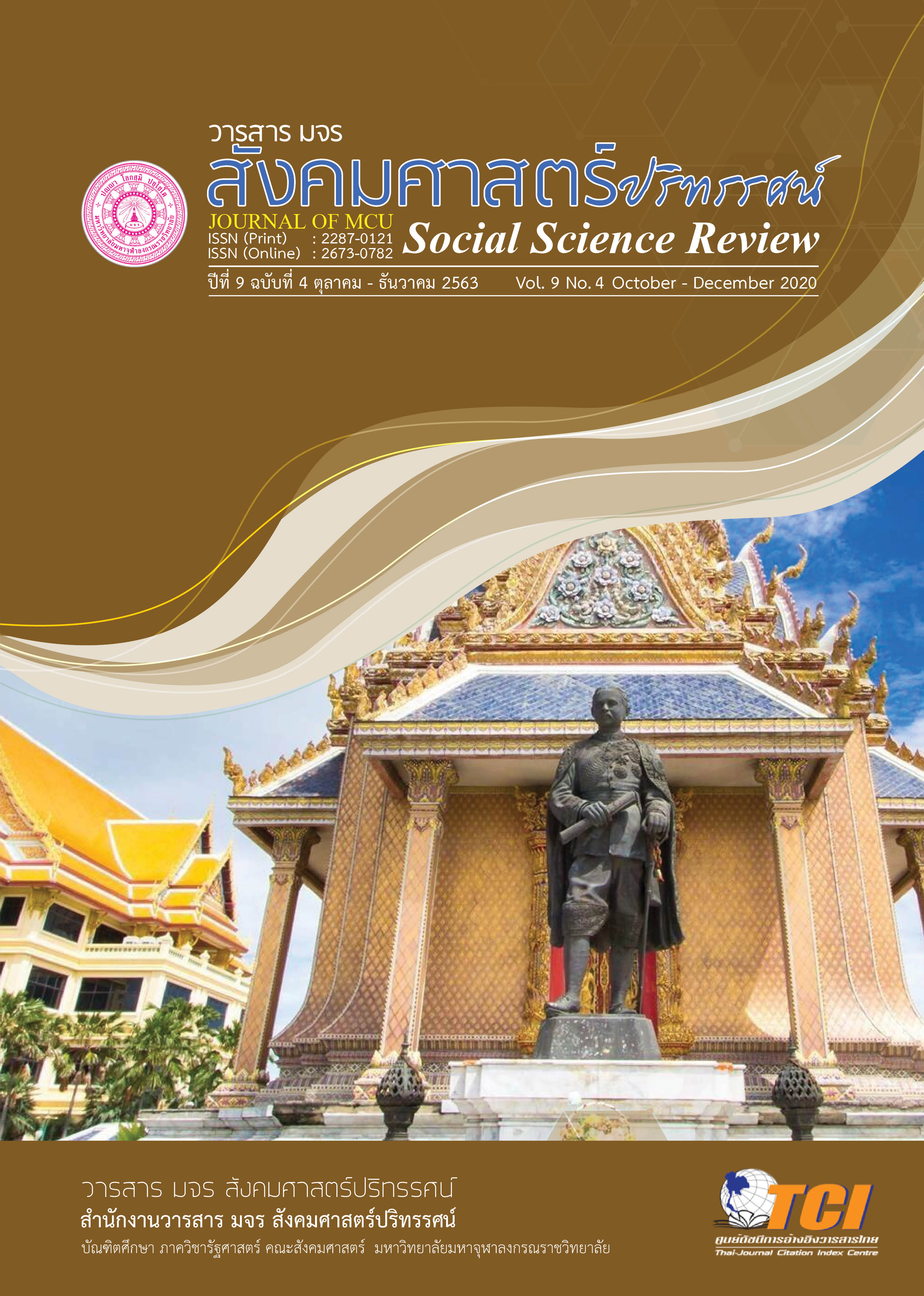แนวทางพัฒนาการจัดการศึกษาระดับปฐมวัยของศูนย์พัฒนาเด็กเล็กสังกัดองค์กรปกครองส่วนท้องถิ่นตามมาตรฐานสถานพัฒนาเด็กปฐมวัยแห่งชาติ พ.ศ. 2562
คำสำคัญ:
มาตรฐานสถานพัฒนาเด็กปฐมวัยแห่งชาติ, แนวทางพัฒนา, ศูนย์พัฒนาเด็กเล็กบทคัดย่อ
บทความวิจัยนี้มีวัตถุประสงค์เพื่อศึกษาสภาพปัจจุบันและปัญหาและแนวทางการจัดการศึกษาระดับปฐมวัยของศูนย์พัฒนาเด็กเล็กตามมาตรฐานสถานพัฒนาเด็กปฐมวัยแห่งชาติ พ.ศ. 2562 ประชากรคือศูนย์พัฒนาเด็กเล็ก 19,192 ศูนย์ กลุ่มตัวอย่างคือศูนย์พัฒนาเด็กเล็ก 377 ศูนย์ การสุ่มตัวอย่างกำหนดขนาดกลุ่มโดยใช้ตารางของเครซี่และมอร์แกน (Krejcie & Morgan) ข้อมูลศูนย์ละ 3 คน ได้แก่ นักวิชาการหรือผู้ช่วย 1 คน หัวหน้าศูนย์หรือรักษาการ 1 คน ครูผู้ดูแลเด็กหรือผู้ช่วย 1 คน รวมทั้งสิ้น 1,131 คน เครื่องมือที่ใช้ในการเก็บรวบรวมข้อมูล ได้แก่ แบบสอบถาม วิเคราะห์ข้อมูลโดยการหาค่าเฉลี่ย ค่าส่วนเบี่ยงเบนมาตรฐาน และการวิเคราะห์เนื้อหา ผลการวิจัยพบว่า 1. สภาพปัจจุบันการจัดการศึกษาระดับปฐมวัยของศูนย์พัฒนาเด็กเล็กในภาพรวม อยู่ในระดับปานกลาง (=3.49, S.D.=0.97) และมีปัญหาอยู่ในระดับปานกลาง (
=2.58, S.D.=0.98) 2. ผลการศึกษาแนวทางพัฒนาการจัดการศึกษาระดับปฐมวัยของศูนย์พัฒนาเด็กเล็ก ตามมาตรฐานสถานพัฒนาเด็กปฐมวัยแห่งชาติ พ.ศ. 2562 ได้แก่ 2.1 ด้านการบริหารจัดการศูนย์เด็กเล็ก ควรมีการจัดงบประมาณ พัฒนาอาคารสถานที่ จัดอัตรากำลังครู 2.2 ครู/ผู้ดูแลเด็ก จัดหาสื่อ อุปกรณ์ให้เพียงพอ การจัดทำแผนการจัดประสบการณ์การนิเทศ 2.3 คุณภาพเด็ก ส่งเสริมการดูแลสุขภาพ กล้าแสดงออก มีปฏิสัมพันธ์กับผู้อื่น ด้านการคิด การใช้ภาษา
เอกสารอ้างอิง
กระทรวงมหาดไทย. (2545). คู่มือศูนย์พัฒนาเด็กเล็กองค์กรปกครองส่วนท้องถิ่น. กรุงเทพฯ: กรมการปกครอง.
กระทรวงศึกษาธิการ. (2560). หลักสูตรการศึกษาปฐมวัย พุทธศักราช 2560. กรุงเทพฯ: สำนักวิชาการและมาตรฐานการศึกษา สำนักงานคณะกรรมการการศึกษาขั้นพื้นฐาน.
กุลยา ตันติผลาชีวะ. (2552). การจัดกิจกรรมการเรียนรู้สำหรับเด็กปฐมวัย. กรุงเทพฯ: เบรน เบส บุคส์.
จรรยา ชินสี. (2552). แนวทางพัฒนาการจัดการศึกษาระดับปฐมวัยของศูนย์พัฒนาเด็กเล็กในอำเภอแม่ริม จ. เชียงใหม่. เชียงใหม่: มหาวิทยาลัยเชียงใหม่.
ณัฐชยาน์ สนินัด. (2553). แนวทางการจัดการปัจจัยที่เอื้อต่อการบริหารหลักสูตรการศึกษาปฐมวัย ของโรงเรียนในสังกัดองค์กรปกครองส่วนท้องถิ่น ในจังหวัดเชียงใหม่. เชียงใหม่: มหาวิทยาลัยเชียงใหม่.
นิตยา ภัสสรศิริ. (2556). การพัฒนาระบบประกันคุณภาพสำหรับสถานพัฒนาเด็กปฐมวัยที่เหมาะสมกับท้องถิ่น. นนทบุรี: มหาวิทยาลัยสุโขทัยธรรมาธิราช.
ยุทธนา มิ่งเมือง. (2554). การบริหารจัดการศูนย์พัฒนาเด็กเล็กเทศบาลเมืองคูคต จังหวัดปทุมธานี. กรุงเทพฯ: มหาวิทยาลัยศิลปากร.
รัตมณี เสนีกาญจน์ และศันสนีย์ จะสุวรรณ์. (2560). การพัฒนารูปแบบการจัดการเรียนรู้ในศตวรรษที่ 21 เพื่อส่งเสริมความคิดสร้างสรรค์ของนักเรียนชั้นประถมศึกษา. วารสาร มจร สังคมศาสตร์ปริทรรศน์, 6(3), 86-99.
สำนักงานเลขาธิการสภาการศึกษา. (2562). มาตรฐานสถานพัฒนาเด็กปฐมวัยแห่งชาติ. กรุงเทพฯ: พริกหวานกราฟฟิค จำกัด.
สิริภรณ์ สุริวงษ์และคณะ. (2563). การศึกษาผลการจัดการเรียนรู้แบบเน้นประสบการณ์ และการเรียนรู้จากบทเรียนคอมพิวเตอร์ช่วยสอน ที่มีต่อทักษะพื้นฐานทางวิทยาศาสตร์ของเด็กปฐมวัย. วารสาร มจร สังคมศาสตร์ปริทรรศน์, 9(1), 59-68.
ดาวน์โหลด
เผยแพร่แล้ว
รูปแบบการอ้างอิง
ฉบับ
ประเภทบทความ
สัญญาอนุญาต
ลิขสิทธิ์ (c) 2020 วารสาร มจร สังคมศาสตร์ปริทรรศน์

อนุญาตภายใต้เงื่อนไข Creative Commons Attribution-NonCommercial-NoDerivatives 4.0 International License.
เพื่อให้เป็นไปตามกฎหมายลิขสิทธิ์ ผู้นิพนธ์ทุกท่านต้องลงลายมือชื่อในแบบฟอร์มใบมอบลิขสิทธิ์บทความให้แก่วารสารฯ พร้อมกับบทความต้นฉบับที่ได้แก้ไขครั้งสุดท้าย นอกจากนี้ ผู้นิพนธ์ทุกท่านต้องยืนยันว่าบทความต้นฉบับที่ส่งมาตีพิมพ์นั้น ได้ส่งมาตีพิมพ์เฉพาะในวารสาร มจร สังคมศาสตร์ปริทรรศน์ เพียงแห่งเดียวเท่านั้น หากมีการใช้ภาพหรือตารางหรือเนื้อหาอื่นๆ ของผู้นิพนธ์อื่นที่ปรากฏในสิ่งตีพิมพ์อื่นมาแล้ว ผู้นิพนธ์ต้องขออนุญาตเจ้าของลิขสิทธิ์ก่อน พร้อมทั้งแสดงหนังสือที่ได้รับการยินยอมต่อบรรณาธิการ ก่อนที่บทความจะได้รับการตีพิมพ์ หากไม่เป็นไปตามข้อกำหนดเบื้องต้น ทางวารสารจะถอดบทความของท่านออกโดยไม่มีข้อยกเว้นใดๆ ทั้งสิ้น





